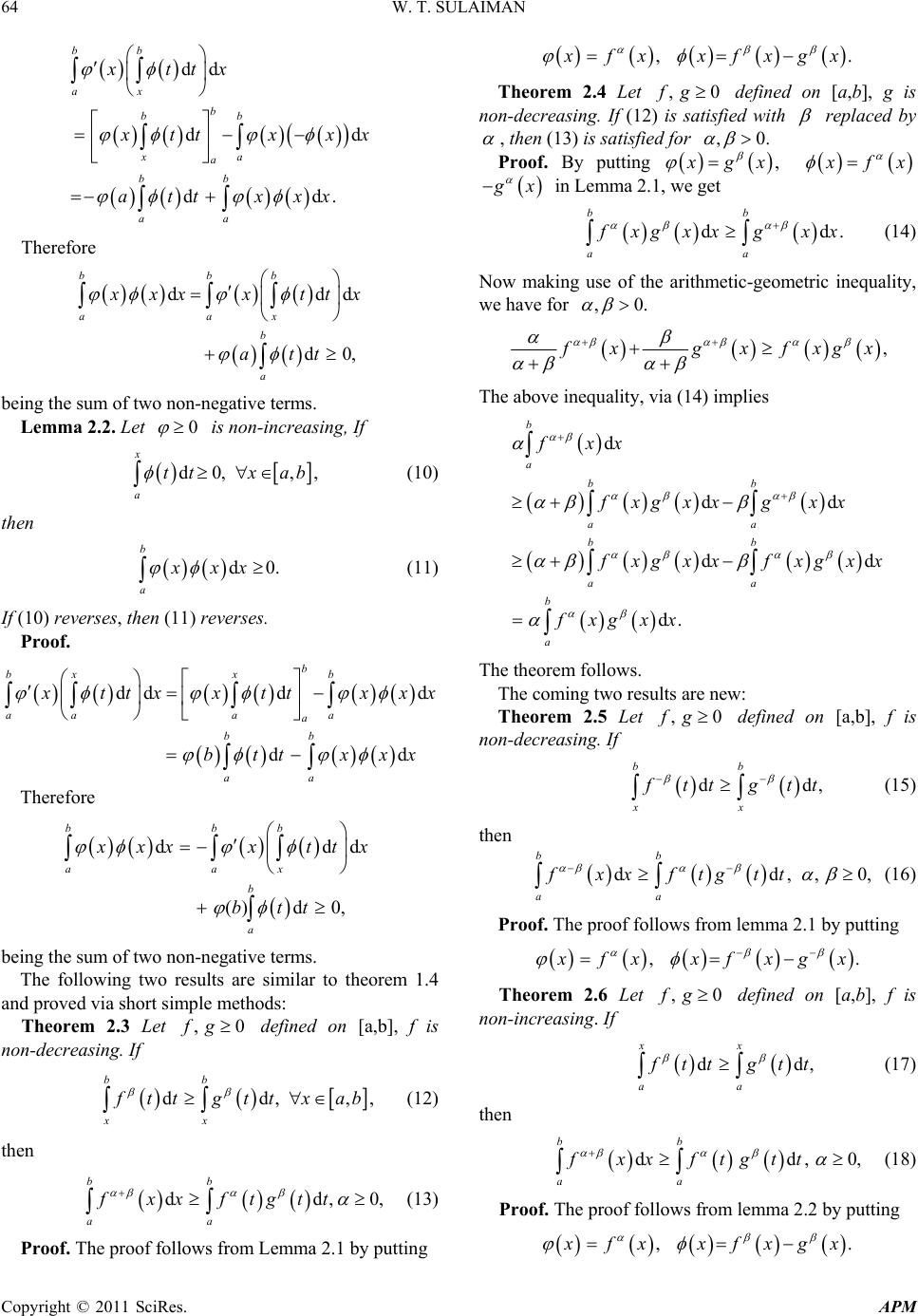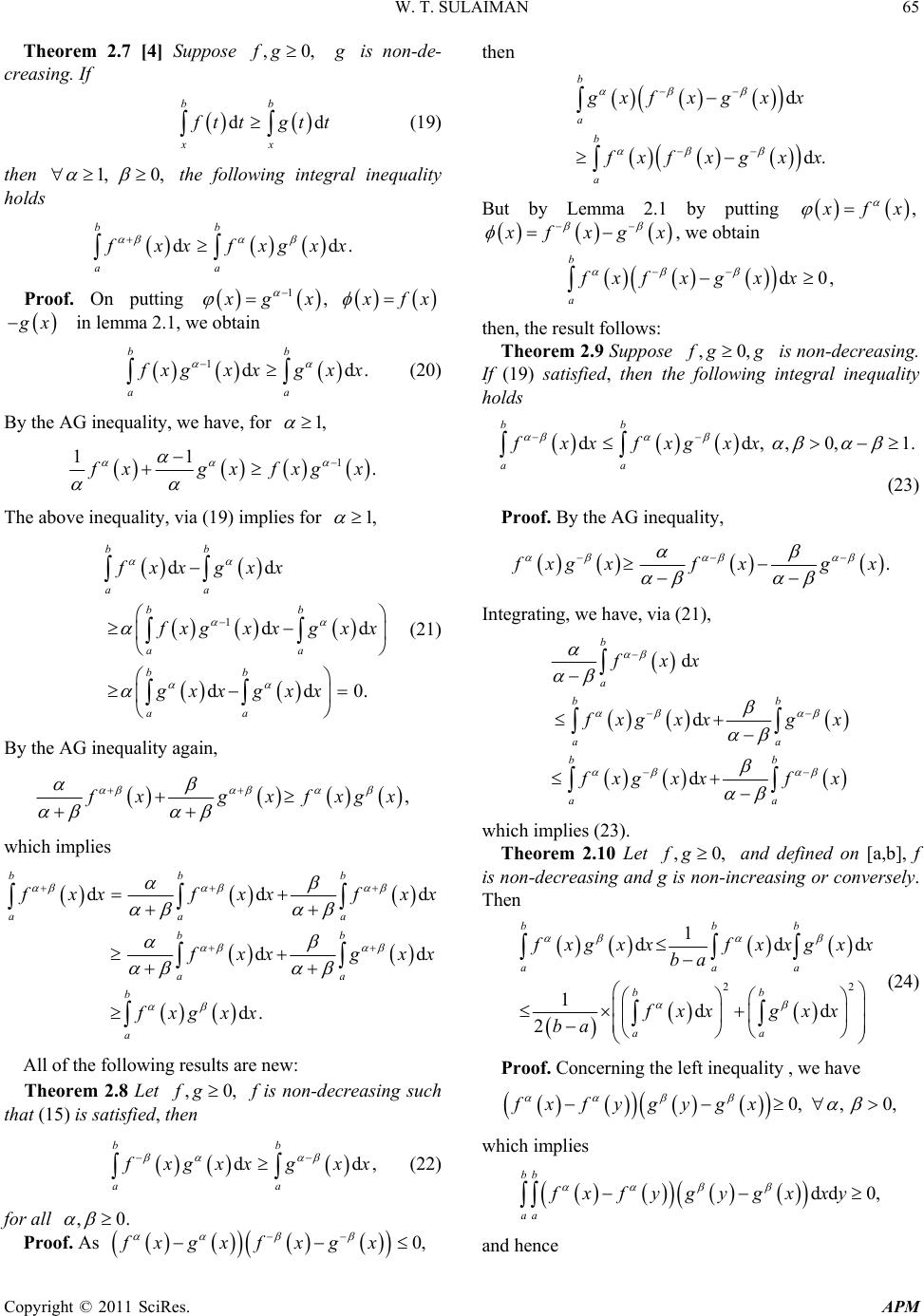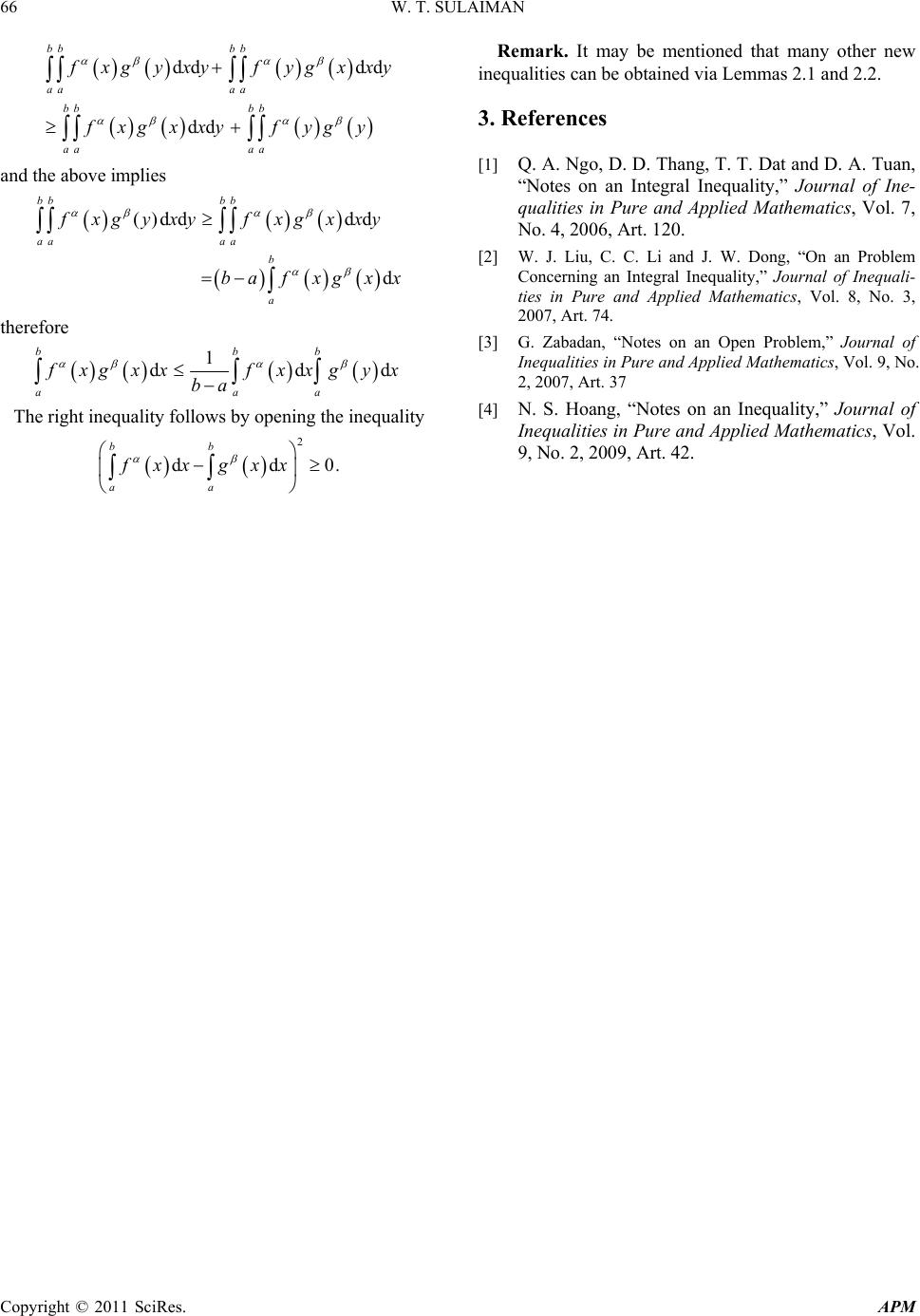Paper Menu >>
Journal Menu >>
 Advances in Pure Mathematics, 2011, 1, 63-66 doi:10.4236/apm.2011.13014 Published Online May 2011 (http://www.scirp.org/journal/apm) Copyright © 2011 SciRes. APM Several Ideas on Some Integral Inequalities Waadallah T. Sulaiman Department of C om put er E ngineering, College of Engineering, University of Mosul, Mosul, Iraq E-mail: waadsulaiman@hotmail.com Received March 4, 2011; revised March 14, 2011; accepted March 20, 2011 Abstract Several new integral inequalities are presented via new ideas. Keywords: Integral Inequality 1. Introduction In [1] the following result was proved Theorem 1.1. If 0f is continuous function on [0,1] such that 11 dd, 0,1 xx ft tttx (1) then 11 1 00 dd,0fxxxfxx (2) and the following question was posed. If f satisfies the above assumption, under what addi- tional assumption can one claim that 11 00 dd,,0fxxxfxx (3) The following result as well, was achieved in [2] Theorem 1.2 If 0f is a continuous function on [0,b] satisfying dd,0, 0, bb xx f ttt tbxb (4) then 00 dd,0. bb fxxxfxx (5) In their roles, Zabadan [3] and Hoang [4] generalized the previous results by introducing the following theorems respectively. Theorem 1.3 Suppose 1 ,,,,0, f gLab fgg is non-decreasing. If dd,,, bb xx f ttgttx ab (6) then dd,,0,1 bb aa fxxfxgxx ( 7) Theorem 1.4 Suppose 11 ,, ,fL abgCab ,0,fg gis non-decreasing. If dd,,, bb xx f ttgttx ab then ,0, 1, the following integral ine- quality holds dd. bb aa fxxfxgxx The object of this paper is to prove some of the above results via simpler methods as well as to present some other new results . 2. Results We start with the following: Lemma 2.1 Let 0 is non-decreasing on ,ab , If d0, ,, b x tt xab (8) then d0. b a xxx (9) If (8) reverses, then (9) reverses. Proof.  W. T. SULAIMAN Copyright © 2011 SciRes. APM 64 dd dd dd. bb ax b bb xa a bb aa xttx x ttxx x att xxx Therefore ddd d0, bbb aax b a x xxx ttx att being the sum of two non-negative terms. Lemma 2.2. Let 0 is non-increasing, If d0,,, x a tt xab (10) then d0. b a xxx (11) If (10) reverses, then (11) reverses. Proof. dd dd dd b bxx b aaa a a bb aa x ttxxttx xx btt xxx Therefore ddd ()d 0, bbb aax b a x xxx ttx btt being the sum of two non-negative terms. The following two results are similar to theorem 1.4 and proved via short simple methods: Theorem 2.3 Let ,0fg defined on [a,b], f is non-decreasin g. If dd,,, bb xx f ttgttx ab (12) then dd,0, bb aa fxxftgtt (13) Proof. The proof follows from Lemma 2.1 by putting ,. x fx xfxgx Theorem 2.4 Let ,0fg defined on [a,b], g is non-decreasing. If (12) is satisfied with replaced by , then (13) is satisfied for ,0. Proof. By putting , x gx x fx g x in Lemma 2.1, we get dd. bb aa f xgx xgxx (14) Now making use of the arithmetic-geometric inequality, we have for ,0. , f xgxfxgx The above inequality, via (14) implies d dd dd d. b a bb aa bb aa b a fxx fxgxxg xx f xgx xfxgx x fxgxx The theorem follows. The coming two results are new: Theorem 2.5 Let ,0fg defined on [a,b], f is non-decreasing. If dd, bb xx ftt gtt (15) then dd,,0, bb aa fxxftgtt (16) Proof. The proof follows from lemma 2.1 by putting ,. x fxxfxg x Theorem 2.6 Let ,0fg defined on [a,b], f is non-increasing . If dd, xx aa ftt gtt (17) then dd,0, bb aa fxxftgtt (18) Proof. The proof follows from lemma 2.2 by putting ,. x fx xfxgx  W. T. SULAIMAN Copyright © 2011 SciRes. APM 65 Theorem 2.7 [4] Suppose ,0,fg g is non-de- creasing. If dd bb xx ft tgtt (19) then 1, 0, the following integral inequality holds dd. bb aa fxxfxgxx Proof. On putting 1, x gx x fx g xin lemma 2.1, we obtain 1dd. bb aa f xgx xgx x (20) By the AG inequality, we have, for 1, 1 11 . f xgxfxgx The above inequality, via (19) implies for 1, 1 dd dd dd0. bb aa bb aa bb aa fxxgxx f xgx xgx x gxxgxx (21) By the AG inequality again, , f xgxfxgx which implies ddd dd d. bbb aaa bb aa b a f xxf xxf xx f xxg xx fxgxx All of the following results are new: Theorem 2.8 Let ,0,fg f is non-decreasing such that (15) is satisfied, then dd, bb aa f xgxxgx x (22) for all ,0. Proof. As 0,fxgxfxg x then d d. b a b a g xfx gx x f xfx gx x But by Lemma 2.1 by putting , x fx x fxgx , we obtain d0, b a fxfxg xx then, the result follows: Theorem 2.9 Suppose ,0,fg g is non-decreasing. If (19) satisfied, then the following integral inequality holds dd,,0,1. bb aa fxxfxgxx (23) Proof. By the AG inequality, . f xg xfxgx Integrating, we have, via (2 1) , d d d b a bb aa bb aa fxx f xgx xgx f xgx xfx which implies (23). Theorem 2.10 Let ,0,fg and defined on [a,b], f is non-decreasing and g is non-increasing or conversely. Then 22 1 ddd 1dd 2 bbb aaa bb aa f xg xxfxxg xx ba fxx gxx ba (24) Proof. Concerning the left inequality , we have 0, ,0,fxfygygx which implies dd 0, bb aa fxfy gygxxy and hence  W. T. SULAIMAN Copyright © 2011 SciRes. APM 66 dd dd dd bb bb aa aa bb bb aa aa f xgy xyfygx xy fxgxxyfygy and the above implies ()dddd d bb bb aa aa b a f xgy xyfxgxxy bafxg xx therefore 1 ddd bbb aaa f xgx xfx xgy x ba The right inequality follows by opening the inequality 2 dd0. bb aa fxx gxx Remark. It may be mentioned that many other new inequalities can be obtained via Lemmas 2.1 and 2.2. 3. References [1] Q. A. Ngo, D. D. Thang, T. T. Dat and D. A. Tuan, “Notes on an Integral Inequality,” Journal of Ine- qualities in Pure and Applied Mathematics, Vol. 7, No. 4, 2006, Art. 12 0. [2] W. J. Liu, C. C. Li and J. W. Dong, “On an Problem Concerning an Integral Inequality,” Journal of Inequali- ties in Pure and Applied Mathematics, Vol. 8, No. 3, 2007, Art. 74. [3] G. Zabadan, “Notes on an Open Problem,” Journal of Inequalities in Pure and Applied Mathematics, Vol. 9, No. 2, 2007, Art. 37 [4] N. S. Hoang, “Notes on an Inequality,” Journal of Inequalities in Pure and Applied Mathematics, Vol. 9, No. 2, 2009, Art . 42 . |

